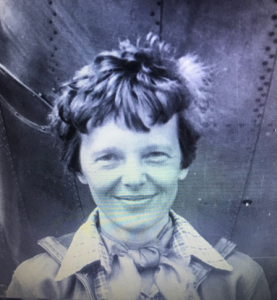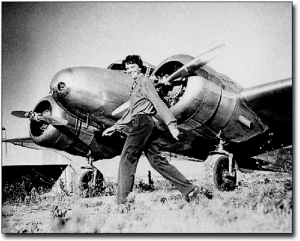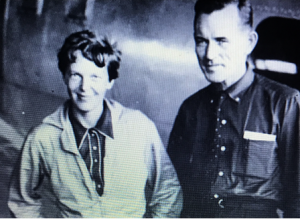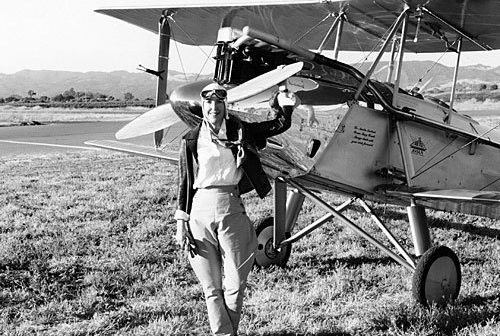 The Grampaw Pettibone Squadron was honored to have Steve Lund, LTC USA(Ret) share his knowledge and research regarding the events and controversy surrounding the disappearance of Amelia Earhart and Fred Noonan on their historic flight in 1937. Cindy Macha, GPS Ops Officer introduced our speaker.
The Grampaw Pettibone Squadron was honored to have Steve Lund, LTC USA(Ret) share his knowledge and research regarding the events and controversy surrounding the disappearance of Amelia Earhart and Fred Noonan on their historic flight in 1937. Cindy Macha, GPS Ops Officer introduced our speaker.
From that date in 1937 to today, mystery has surrounded the events of the disappearance of the aircraft and crew. Steve’s talk presented evidence to support one theory.
Steve began his talk by noting that he has been following the story and research since the early 60s when TV journalist Ted Goerner first started to investigate stories that the journey of Amelia Earhart and Fred Noonan ended on Saipan. Our speaker noted that during the research by Mr. Goerner, numerous events occurred that blocked his investigation in learning the truth about the disappearance of the Lockheed Electra and crew. Our speaker’s interest increased the more he heard about the investigation and resistance that appeared. His initial comments noted what he felt was a cover-up by authorities.
 The mystery and the passage of time has increased the number of causes and explanations for the disappearance. The official explanation was she got lost, missed Howland Island, her designated stop, ran out of gas landing in the water and drowned. This has been the official story ever since.
The mystery and the passage of time has increased the number of causes and explanations for the disappearance. The official explanation was she got lost, missed Howland Island, her designated stop, ran out of gas landing in the water and drowned. This has been the official story ever since.
Over time new explanations are presented and when this occurs the official word is presented to defuse speculation. However, according to our speaker, whenever the official word is presented to refute new supportable evidence, the official word is suspect. The more evidence presented, the more skepticism appears regarding the official word.
The second theory that has been presented on the History Channel and supported by TIGHAR (The International Group for Historic Aircraft Recovery) is a result of a navigation error. The aircraft was blown off-course and landed on a reef near Nikumaroro Island (Gardner Island). This is well south of course. Over eleven searches to this location with numerous sponsors have been conducted by TIGHAR to seek evidence of the plane or crew at this location. Reports that she continued to broadcast for 3 days after her expected arrival supported the theory that she was able to start an engine for battery power and use her radio.
Bones found in 1940 on Nikumaroro Island —were initially thought to belong to Amelia Earhart. They were found alongside a number of possessions that could have belonged to her, including a shoe; a box designed to hold a navigation device similar to the one used by her navigator Fred Noonan; and a bottle, which she was known to carry with her. But when a researcher measured and analyzed the bones in 1940, he determined they belonged to a man, dashing the idea that they belonged to the legendary pilot. Further analysis of the bones could not occur due to their disappearance. The bones were subsequently found and reexamined. More advanced equipment concluded the bones were from a man. Further evidence confirmed that the island was inhabited during the war and additional research did not reveal any evidence of any aircraft matching the one flown by Earhart.
The third theory our speaker found more plausible due to recent evidence was one supporting the belief the flight was a spy mission to overfly Japanese held islands at Truk and Kwajalein Atoll and ran out of fuel on her way to Howland Island. This is the interesting theory to be discussed.
When speaking about Amelia Earhart and her contribution to the field of aviation, mixed opinions exist. The achievements over the 10-12 year period that marked her accomplishments could support a belief she was pretty remarkable in her drive, ambition and achievements. The suggestion she was not capable was based on statements from Paul Mantz, her technical advisor on the first attempt for the around the world flight when she crashed on take-off. Amelia Earhart’s navigator on the second flight, Fred Noonan, had only good things to say. There were a number of detractors who commented on Fred Noonan’s ability and habits in spite of his skills and demonstrated ability.
The first flight that resulted in the accident at take-off included a series of questionable factors. Fuel requirements at take-off did not appear sufficient to support such a mission. Aircraft repairs which proved costly were beyond the financial resources of Amelia Earhart or her husband George Putnam. The funding for the purchase of the aircraft came from the US Navy. Considerable press coverage during her initial flight was virtually non-existent during the repairs and preparation for the subsequent and final departure. The aircraft received upgraded engines, configuration changes to the structure that included longer wings, the addition of aerial survey cameras, added fuel tanks which increased the range by 6 hours and the latest navigation equipment. Press reports did not indicate these additions.
Geopolitical conditions in the Pacific at this time reflected Japanese expansion. Islands previously held by Germany were conveyed to Japan as a result of WWI terms that benefited Japan. The acquired Central Pacific islands were not to be fortified according to treaty provisions from WWI. Our speaker noted that even if the flight had been successful in photographing the islands it flew over, the Japanese would have made improvements that would not have revealed any military presence, but appeared to be for the benefit of the population, such as improved infrastructure and not any military improvements.
Steve presented information to support the third theory that the flyers had been in the Marshall Islands. He noted that the aircraft was modified for long range flight with on-board camera system, the crew agreed to the mission and the US government controlled the release of information regarding the flight and subsequent search.
The information presented supported the theory that the flight diverted from the original path flew over Truk, a major Japanese military base and then east bound towards Kwajalein, another military facility, followed by resuming the presumed route towards Howland Island. However, winds aloft were stronger than predicted which forced the plane down along the route.
Additional evidence in 1987 supported such conclusions when the local island government issued a Commemorative Stamp series depicting the events that occurred some 50 years prior. The stamps; depicted the water landing on a reef landing near Mili Atoll, noted arrival of a ship and transporting of the aircraft by barge towed by a ship.
According to our speaker, residents of Mili Atoll and Jaluit in the Marshall Islands knew of the existence of both people beginning July 1937. They claim the aircraft made a water landing on a reef off the coast of Barre Island, Mili Atoll in July 1937. The crew were observed in the aircraft and on the island and at one time buried what was described as a silver box. The box was never located. During this same period radio messages were received by US personnel monitoring radio frequencies for the missing aircraft. It was suggested that the location of a transmitter on the aircraft was operational due to the manner in which the plane landed and with an engine turned on, could transmit. Eventually Japanese military arrived and took the crew and secured the aircraft.
 Witnesses were questioned by US personnel who occupied the area in 1944. The witnesses described who they believed to be a white man and woman, and an aircraft moved to an awaiting barge and transported to the island of Jaluit. A subsequent photo identified as a file photo from US Office of Naval Intelligence records claim to have been taken at the time suggest the presence of personnel that match the description of both Amelia Earhart and Fred Noonan. In the same photo there appears to be an aircraft secured on a barge and attached to a ship at a dock in Jaluit. It was further stated that the aircraft and crew were eventually transported to the island of Saipan for disposition by the Japanese authorities. Some dispute regarding the time the photo was taken raised questions as to the authenticity of the evidence that the photo identified both Earhart and Noonan. According to our speaker, corroboration did support the belief the photo was accurate in identifying both people.
Witnesses were questioned by US personnel who occupied the area in 1944. The witnesses described who they believed to be a white man and woman, and an aircraft moved to an awaiting barge and transported to the island of Jaluit. A subsequent photo identified as a file photo from US Office of Naval Intelligence records claim to have been taken at the time suggest the presence of personnel that match the description of both Amelia Earhart and Fred Noonan. In the same photo there appears to be an aircraft secured on a barge and attached to a ship at a dock in Jaluit. It was further stated that the aircraft and crew were eventually transported to the island of Saipan for disposition by the Japanese authorities. Some dispute regarding the time the photo was taken raised questions as to the authenticity of the evidence that the photo identified both Earhart and Noonan. According to our speaker, corroboration did support the belief the photo was accurate in identifying both people.
Research teams on Barre Island in 2011 did locate and identify abandoned equipment supporting the story that some sort of track was placed to move a large object across a portion of the island to a beach area for subsequent loading on a ship of some kind. Artifacts located on the island near the point of the barge location may be parts of the aircraft, however, further testing dismissed the authenticity of some of the parts since the type of metal found did not exist at the time of the flight. Other parts could have been part of the Electra based on size and appearance.
The presentation included additional information that US personnel on Saipan after the US secured the island did view and identify the aircraft previously moved by barge and located property belonging to Amelia Earhart. Additional testimony from a local native stated her father executed the pilot. The presentation referenced a list of American soldiers and local inhabitants who testified to the evidence supporting the presence of both Earhart and Noonan and their eventual demise.
Further evidence in US National Archives contained reference to identification and location of the missing plane and crew on January 7, 1939. This information was based on evidence presumably collected through monitoring coded Japanese messages. Since the US had broken the Japanese military code, to reveal knowledge of this could impact the US ability to secretly monitor Japanese communication during the war. Our speaker stated that this knowledge and the subsequent location and identification of the aircraft in 1944 on Saipan would not be revealed in order to protect the reputation of US leadership.
The conclusion of the presentation supports the belief that; the original aircraft was intentionally damaged by Amelia Earhart. The subsequent aircraft was specially constructed for intelligence gathering. The Roosevelt administration disavowed all knowledge of the mission to protect the code breaking previously achieved. The eventual location of the aircraft and evidence was suppressed to protect the administration.




